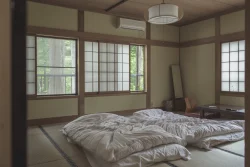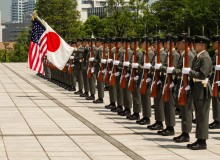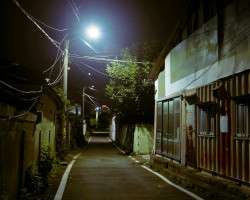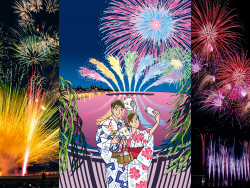
January 20, 2006
Spectacle in the Sand
Dubai Defies Physics, Geography and Cost in Pursuit of the Cutting Edge
By Metropolis
Originally published on metropolis.co.jp on January 2006

Photos by Jeffrey Tanenhaus
Cruising down Dubai’s Sheikh Zayed Road leaves the impression that there is nothing petrodollars can’t build. Indeed, the crown prince seems to be playing a reality version of SimDesert, plopping down the largest, tallest or most sumptuous hotel, mall or artificial archipelago.
Dubai is just the second largest of the United Arab Emirates’ seven city-states, but is easily the most alluring. And it’s perhaps the world’s fastest growing tourist destination. Ambitious developers are banking on the “If you build it, they will come” philosophy to lure well-heeled visitors. The construction crane is Dubai’s unofficial bird. Sightings are frequent—16 percent of the worldwide crane population inhabits this emirate. Buildings are categorized as new, brand new or breaking ground. Only sand dunes shift faster than this ultramodern skyline.
The Future

Among the most anticipated projects is the Burj Dubai skyscraper that’s slated to tower approximately 800 meters—half a mile. While the exact height of the tallest man-made structure ever built will remain secret until its 2008 unveiling, it will soar 35 percent higher than the current record holder, Taipei 101, and dwarf the Empire State Building two times over.
To create additional coastline for beachfront residences and resorts, three “palm” islands are making waves. Shaped like date palms (and visible from outer space), this reclaimed sand will jut into the Persian Gulf. Still submerged is the world’s first underwater resort, Hydropolis. It opens in 2007, 20 meters below sea level.
And for when the world itself is not enough, perhaps The World will be. By 2008, about 300 manmade islands, which represent miniaturizations of earth’s landmasses, will house estates for the likes of David Beckham and Rod Stewart.
Thought the Mall of America was larger than life? Behold the Mall of Arabia. It’s just one part of Dubailand, projected to become “the biggest, most varied leisure, entertainment and tourism attraction on the planet.” Its six themed worlds, twice the size of Disney World, will be partially operational come 2008, and will include museums, stadiums, film studios, 55 hotels and—fittingly—the world’s largest Starbucks in the world’s largest mall.
The Present

The “city of merchants” has been transformed into a tax-free culture of builders and buyers. Nothing better enshrines this consumerism than the annual month-long Dubai Shopping Festival. Walk away with keys to a Lexus or a 1kg gold bar at daily raffles during the event, which last winter drew 3.3 million visitors. Not even Ramadan can escape commercial undertones, with midnight mall hours compensating for daytime closure.
Traditional commerce thrives at the gold, spice and fish souks. Here, in the narrow lanes on the Deira side of Dubai Creek, tourists pan for gold jewelry at some of the lowest prices in the world. Still can’t afford the real McCoy? For the best selection of designer knock-offs and cheap souvenirs, hail a cab to Karama souq in the Indo-Pakistani neighborhood. Bargain hard.
In this land of superlatives, the reigning icon is the seven-star Burj Al Arab, the world’s tallest and most luxurious hotel (for now). Inside this sail-inspired structure, visitors are sprayed with rosewater before ascending escalators flanked by aquariums. Everything shimmers, from golden wastepaper cans to elevator banks. Have a drink at the Skyview bar, or spend the night (from $1,333 with private butler).
Despite scorching summers above 40°C, snow in the desert is a mirage no longer. This month, Ski Dubai opened as the world’s largest indoor snow park with five trails, a quarter-pipe snowboard area and, this being Arabia, a flying carpet lift.
The Past

Dubai may not possess Old World charm, but some cultural alternatives exist to its sleek modernity.
First stop should be the Dubai Museum housed in Al-Fahidi Fort, dating from the late 1700s. Dioramas and a recreation of a Bedouin village showcase local history, ecology and demographics. Brush up on camel facts, and don’t miss the sharkskin shield and goatskin bagpipes with goat-hair tassels.
Sheikh Saeed al-Maktoum’s restored house from 1896 exhibits an impressive collection of photos documenting Dubai as a backwater fishing and pearling village before the discovery of oil in the ’60s forever altered the landscape.
The Bastakia Quarter, once home to wealthy Iranian merchants, is now preserved as a historic district with a few galleries. Houses feature courtyards and distinctive wind towers, which funneled breezes into bedrooms. Wandering Bastakia’s passageways at dusk is especially tranquil, disturbed only by prayer-goers on their way to mosques. Echoes of the muezzin remind visitors of this land’s Islamic roots.
Dubai’s extravagant image shouldn’t deter those without pocketbooks of gold, as the city is rewarding on any budget. Taxis are an affordable necessity. Rickety abras ferries carry boatloads of commuters and tourists across the creek for pocket change. Middle Eastern and Indian cuisines are served in generous portions at cafeterias.
In Dubai, the past is ancient history, the present was yesterday, and the future is now. Aside from year-round sunshine and shopping, one more thing’s for sure—guidebooks will require frequent updating.
JAL offers daily nonstop flights to Dubai from Osaka. Five-star accommodations cluster seaside in Jumeirah and along Sheikh Zayed Road, as the party capital of the Arab world draws a cosmopolitan, multilingual crowd with international DJs to these hotel venues. Dress conservatively when in public. Beat the heat and travel from December through February, when the average temperature is 25C. The weekend is Thu-Fri, and businesses and attractions often close 1-4pm. Dubai buzzes during the 11th annual Shopping Festival, through Feb 4. Lonely Planet Dubai makes for a trusty travel companion.
[geo_mashup_map]







